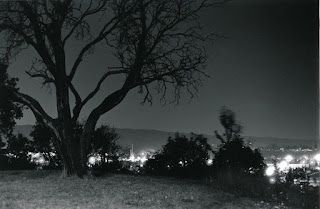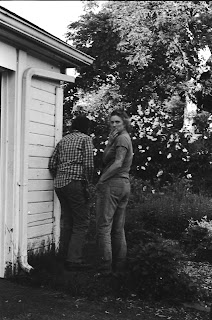In October my family spent a weekend at a friend of my Mother's in Fly Creek, NY, just 20 east of Edmeston, the town where my Great Great Grandfather farmed. My mom drove Eli and I out to Edmeston one evening to tour the old family sites. My intention was to return the following morning at dawn to photograph the original farm and surrounding areas. My plan was flawed as I did not take into account the placement of the farmhouse in an old river valley and where the morning light would place shadows. I wish now I had come in late afternoon for preferable lighting under the circumstances. I spent those early hours driving the roads that enclosed the area of the Rhood farm to find optimum views to photograph from. On the second or third time up Wilkinson Hill Road, I discovered these birch trees illuminated by the first rays of sun to crest over the hill. This grove of trees sits on the southern wedge of land where the Rhood family farm lays out.
Madrone Tree, North Portland Bluffs
North Portland Bluffs. 120 monochrome, Mamiya C330
Andrew and Kathryn, in front of their Lennox Street apartment, Brooklyn, NY.
35mm E6, Cannon F1
Fran's Cabin, Central Maine, cheap cell phone.
Voss Family back yard, chicken coop, Kittery Point, ME
E. and A., back yard, N. Portland. 35mm monochrome, Canon F1.
Voss in law apartment, and bird feeder, Kittery Piont, ME. Cheap cell phone.
Self portrait, Lake Billy Chinook overlook, Madras, OR. 35mm E6, Canon F1 with pinhole cap.
North of Tigh Valley, OR. 35mm monochrome, Canon F1
Mt. Tabor, Portland, OR. 120 monochrome, Mamiya C330
New Photographs, Autumn 2013:::
[This is old text from photographs that had been removed by Blogger, likely from inactivity, as there was no controversial content. I left the text although the images are gone. a few I have reposted above.]Here are a few more recent prints I've produced. The first two are a bit older images captured in the summer 2013. The latter three were captured on a camera I purchased in September 2013. In the weeks leading up to our trip back to the Northeast, I was trying to imagine how I would transport my medium format camera and tripod back with me without having to check any baggage.
The medium format single lens reflex camera incorporates a large mirror that allows the photographer to see the exact image that will be exposed onto the film. When the shutter is triggered, that mirror has to quickly move out of the path of light to allow the film to be exposed. The mirror in a 120 roll film aka medium format camera is proportionally larger than that of a 35mm camera and as it moves the camera vibrates. This is especially a problem when using shutter speeds slower than 1/125th of a second that can result in an out of focus image. Use of faster shutter speeds requires opening the lens aperture up to let in more light for that shorter exposure time. This diminishes the depth of field, making objects behind and in front of the subject more or less out of focus relative to the primary subject which can detract from the final image depending on the intention.
Thus, many medium format single lens reflex cameras are constructed with a feature that locks the mirror out of the way. To use such a function is very inconvenient without the aid of a tripod. You can not view the scene and correct the cropping of the image when the mirror is in lock up position.
To resolve this equation I began to consider the idea of finding a twin lens camera. The twin lens camera incorporates two lenses as the name suggests, one lens above the other. The upper lens takes light in and reflects it off a fixed mirror up to a ground glass that the photographer views the scene through. The lower lens is the lens that light travels through to the film. Thus, the mirror that reflects the image up to where we can see it does not need to move, it remains stationary.
The second benefit of the twin lens camera is the shutter itself. Most single reflex cameras utilize a focal plane shutter that moves just in front of the film within the body of the camera. The movement of the focal plane shutter can also cause the camera to vibrate slightly when triggering the shutter. The twin lens camera utilizes what is called a leaf shutter which is built within each lens. The leaf shutter is made up of a series of thin metal blades that all move in unison to allow light to pass through the lens to the film when the shutter is triggered. The leaf shutter has a much more delicate movement and makes much less sound/vibration as a result.
After a few week's search I came across an ad for the exact twin lens camera I had been hoping to find; the Mamiya C330. The C330 was one of the nicer cameras in the C Series twin lens cameras made in Japan in the 1970's. This particular model boasted all original packaging, manual, and even the leather carrying case. The sellers accepted my offer and so I embarked on a drive through pouring rain out to the coast to purchase the camera. The latter three photographs below are taken with the Mamiya C330. You can distinguish the images from others by the 6 x 6 square format. The 6 x 6 format may be the most common of the medium format cameras. But that's a whole other subject to cover.
Up on the north face of Mt. Hood in early July, slowly I made my way up the trail through the Dollar Lake burn, taking in the unusual landscape left behind, in awe of the transformation wrought by wildfire. Such sad beauty my eyes took in I could barely progress along the trail for wanting to absorb my surroundings. Had it not been my second visit to the area I likely would have been paralyzed by the unusual wildness of it.
A special moment captured at a special place along the wide ribbon of the Columbia River. While cloud cover can dull the effects of direct light dulling it's effect on reflective surfaces, the clouds themselves can become the subject as abstract images designed by the whimsical forces of wind, moisture and air pressure. Their image reflected in the river I imagine one looks at the other in recognition of familiarity.
Autumn is a tricky time for monochrome film, when the dramatic colors compete for our attention while the film can only convey so much. On a brief hike with Andrew and Eli atop the Sleeping Lion, at the north end of glacially formed Otsegeo Lake in central New York, this young maple, flamboyantly showing off beneath it's more dignified elders, could not escape my direct attention. Although printed here, it's plumage is camouflaged by it's surroundings. The eye has to study to appreciate the beautiful form of this singular tree.
Within the hour of departing from where our family had gathered to share a weekend in celebration of my mother's 70th birthday, this image called to me to be captured. The screen door and the shadows of the branches against the back of the house was enough. To add another element, I asked my sister Caitlin to stand inside the screen door. I think she was getting exasperated with the sudden flurry of photographs. But she cheerfully appeased me for this image.












No comments:
Post a Comment